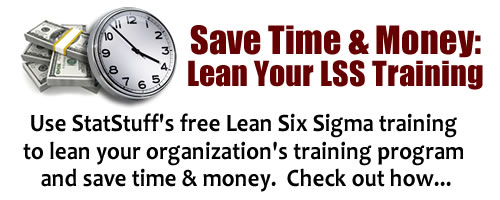Welcome to the world of Lean Six Sigma!
If you're wondering what Lean Six Sigma (LSS) is or if it's meaningful to you, then this is the best place to start. But before we go too far, let's begin dispelling some of the confusing or wrong understandings about LSS by describing what it is NOT:
- LSS is not a magical formula you apply to your business area to automatically get great improvements.
- LSS is not a rigid process or set of steps that must be followed in order to get great improvements.
- LSS is not something you can exclusively learn from a book or a classroom in a short period of time.
- LSS does not require advanced skills in math or statistics (although it can certainly help).
Does that crush your dreams? If so, then let's rebuild them by now describing what LSS is:
- LSS is a logical and flexible method for solving business problems by using various tools/concepts.
- LSS can be learned and applied by anyone without having to attend formal training nor acquire a certification.
- LSS can be successfully applied to virtually any business or industry and has contributed to making huge savings in thousands of organizations.
In general, LSS is used by many businesses to help improve their operational efficiency (i.e., improve speed, time & flow) and effectiveness (i.e., improve quality & accuracy). Many folks describe LSS in terms of reducing waste, defects or variation, but it's much more than that. Reducing waste, defects or variation is merely a means toward reaching the ultimate end goal of improving the financial performance of the business.
LSS is like a GPS
That's right, LSS is like a GPS for your car. Normally, a GPS maps out the route to go from your origin (where you are) to your destination (where you want to go). LSS also maps out the general path you can take to navigate from where you are (i.e., with a business problem you're experiencing) to where you want to go (i.e., your business process with the problem solved). But just as you have flexibility to deviate from the route mapped out by the GPS, you can also deviate from the typical LSS route for solving the problem (as long as it makes sense toward solving your problem).
Where do I start?
You can start by watching the videos listed here. In less than 3 hours time, these 11 videos (hand-picked from the full set of LSS training content offered free from StatStuff) can give you a simple and quick introduction to the fundamentals of LSS. If these aren't enough to whet your appetite for LSS, then check out the Intermediate Path to get a more in-depth understanding of the LSS tools & concepts to help you apply it. Or, you can dive right into the Advanced Path to learn the LSS training content that can help you get certified in LSS.


